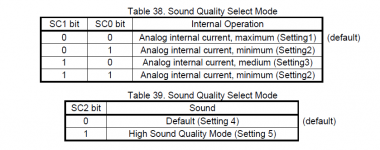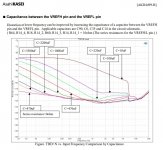No, the precise amount of NFB depends on the components around the opamp. In the context of DACs in a domestic environment, the opamps will be generally used within 10dB of unity gain in my experience - there's seldom any need for voltage gain.
No, the precise amount of NFB depends on the components around the opamp. In the context of DACs in a domestic environment, the opamps will be generally used within 10dB of unity gain in my experience - there's seldom any need for voltage gain.
but an discreet analog output stage is preferable?
or implementing op amps in a way that doesn’t add a ton if NFB and makes the sound lifeless and dull?
A discrete OPS is preferable to my ears. As I already mentioned, there isn't a practical way of implementing opamps which doesn't include 100dB or more (at LF) of NFB.
What leads you to the conclusion that its NFB which gives rise to 'lifeless and dull' sound? Even discrete OPSs are likely to contain NFB (100% shunt FB in an EF for example), its practically unavoidable.
What leads you to the conclusion that its NFB which gives rise to 'lifeless and dull' sound? Even discrete OPSs are likely to contain NFB (100% shunt FB in an EF for example), its practically unavoidable.
that amplifiers which implement a lot of NFB are usually dull and lifeless.A discrete OPS is preferable to my ears. As I already mentioned, there isn't a practical way of implementing opamps which doesn't include 100dB or more (at LF) of NFB.
What leads you to the conclusion that its NFB which gives rise to 'lifeless and dull' sound? Even discrete OPSs are likely to contain NFB (100% shunt FB in an EF for example), its practically unavoidable.
Most amps that use too much NFB are quite stiffled and not open sounding.
i think thats quite a common assessment
i think thats quite a common assessment
it’s mentioned here at around 8:30 for feedback and then goes into feed forward
i may be wrong as well.
not trying to argue
Next you will be saying silver wire sounds bright...Most amps that use too much NFB are quite stiffled and not open sounding.
i think thats quite a common assessment
trueThis is an old and tired argument. Even if you were right, it’s still off topic. I prefer on-topic old and tired arguments 😛.
I don't think NFB is the reason why some dislike modern DACs. It may be just the opposite. They may prefer distortions and colourations even though they don't realize it. Many recordings (especially classical) may sound dull and lifeless so added distortions or noise may "bring life" to the sound.
Getting closer to topic one example of this is with AK449x dacs which have a sound setting. The "high sound quality" modes actually increase distortions.
Getting closer to topic one example of this is with AK449x dacs which have a sound setting. The "high sound quality" modes actually increase distortions.
Attachments
Another similar example is in AK4499EQ evaluation board where AKM added a RC filter on Vref. As can be seen from the attached graph this RC filter mainly adds lf distortion and noise. The best performance is without the RC filter (i.e. series resistance=0 ohm).
Attachments
Last edited:
Many recordings (especially classical) may sound dull and lifeless so added distortions or noise may "bring life" to the sound.
Do you have an example classical recording to share which sounds dull and lifeless?
E.g. some of Hyperion recordings sound quite clinical. I would not be surprised if some may find them dull and lifeless. I did not say they sound dull and lifeless to me.
An opposite example is most Glenn Gould recordings.
But maybe better to stick to the topic 😉
An opposite example is most Glenn Gould recordings.
But maybe better to stick to the topic 😉
I would consider those to be sometimes 'dry' but that is not dull. Oddly few audiophiles consider having a Lexicon in their rack to add some room effect to close miked recordings..
But you would not expect a DAC to add anything like that unless it was very odd.
But you would not expect a DAC to add anything like that unless it was very odd.
What causes 'dull and lifeless' sound isn't necessarily primarily in the amplifier. IME sometimes people use an amplifier that exaggerates dynamics a little bit in order to compensate for some upstream problem or problems in the reproduction chain.that amplifiers which implement a lot of NFB are usually dull and lifeless.
Last edited:
thd is better with rc see 1k to 10k...... and lost only some db under 40hz 😉Another similar example is in AK4499EQ evaluation board where AKM added a RC filter on Vref. As can be seen from the attached graph this RC filter mainly adds lf distortion and noise. The best performance is without the RC filter (i.e. series resistance=0 ohm).
THD type H2-H3 is relate to spatial info tooI don't think NFB is the reason why some dislike modern DACs. It may be just the opposite. They may prefer distortions and colourations even though they don't realize it. Many recordings (especially classical) may sound dull and lifeless so added distortions or noise may "bring life" to the sound.
Getting closer to topic one example of this is with AK449x dacs which have a sound setting. The "high sound quality" modes actually increase distortions.
Depends what you consider better. Typically flat THD+N across audio frequencies is desirable.thd is better with rc see 1k to 10k...... and lost only some db under 40hz 😉
With the filter in place, the sound of the filter caps dominates the sound (we checked). AKM chose the cap values to give the best subjective SQ. Larger value caps made the sound, perceptually speaking, more 'dull and lifeless.' IMHO the reason for the filter in the first place was because the Jung-ish regulator on the main board didn't sound very good (maybe it could be described as grainy). Also it was too far away from the dac chip for a Vref supply, IME a lower impedance connection usually tends to work better.thd is better with rc see 1k to 10k...
EDIT: looks like I was typing at the same time as another member.
Last edited:
- Home
- Source & Line
- Digital Line Level
- AK4499EQ - Best DAC ever

